

4 Expert Tips for Using Video in the Classroom. Teachers are using video in their classrooms in a variety of ways.

Alan Greenberg, a senior analyst at consultancy Wainhouse Research who specializes in technology applications in education, says he has seen “video go from a stand-alone application to one of the features in a larger set of applications.” Learners today will likely seek information from YouTube before consulting a book. It makes sense, then, to capitalize on video of various types to engage learners. Here are some ways educators can better incorporate video into the classroom. 1. There are so many free resources on the Internet, such as YouTube, TeacherTube or Khan Academy. 2. Students today are not shy in front of a camera. 3.
Teachers can also use the new video recording area to record information about lessons. 4. Free tools such as Skype and Google Hangouts or other inexpensive platforms allow educators to connect students directly with experts and peers throughout the world. Er.educause. Since my prior blog post was on making the most of the EDUCAUSE annual conference, I thought this post could highlight some of my takeaways from the conference.
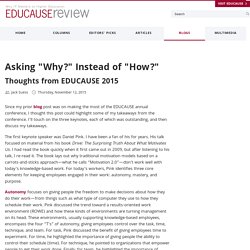
I’ll touch on the three keynotes, each of which was outstanding, and then discuss my takeaways. The first keynote speaker was Daniel Pink. I have been a fan of his for years. His talk focused on material from his book Drive: The Surprising Truth About What Motivates Us. I had read the book quickly when it first came out in 2009, but after listening to his talk, I re-read it. Autonomy focuses on giving people the freedom to make decisions about how they do their work—from things such as what type of computer they use to how they schedule their work. The pursuit of mastery is what drives people to get better at what they do.
Finally, purpose links our individual efforts to the broader efforts to serve others. For those of us who manage others, Pink closed his talk by challenging us with the words why, not how! Seeking > Knowing. Warren Elementary School's Path by chris gamble on Prezi. Visible Thinking. Digital Reporting. Digital reporting tools are not seen to improve student instruction or assessment but have had a significant negative impact on teacher work, according to teachers and principals surveyed in a new Alberta study.

Researchers from the University of Alberta and the Alberta Teachers’ Association surveyed over 1,000 teachers and conducted focus groups with teachers and administrators as part of a study on digital reporting and assessment tools being released today. Nearly two-thirds of teachers reported that digital reporting tools, like PowerSchool and TeacherLogic, have not improved the level of instruction and assessment in classrooms.
The same proportion of teachers also indicated that the tools have had a significant impact on their workload. The Time-Tested Dos and Don'ts of Using Classroom Technology. The choices are endless. Should I set up a class blog or a Twitter account? Should I use Edmodo? Training versus Learning: Changing the Paradigm of Educator Development. I always cringe when I hear the the word “training” used when describing development work with educators.
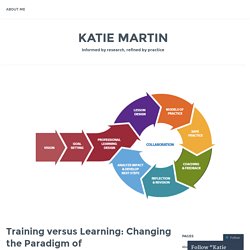
As many people would agree, training seems to be what one does to people as opposed to a process of learning, which is developing knowledge through authentic and relevant experiences. Professional development must move from something that we do to educators to a culture of continuous learning cycles and problem solving that leads to better opportunities for their students. Recently, I was out in the field working with a school leadership team to design systems to support teachers to create site-based professional learning opportunities for their teachers. The Illusion of Inclusion: How We Are Failing Students with Learning Disabilities The education world is abuzz trying to make sense of disheartening findings that, since 2013, scores in reading and math have gone down or remained stagnant across fourth and eighth grades.
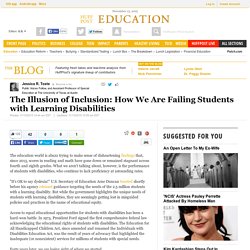
What we aren't talking about, however, is the performance of students with disabilities, who continue to lack proficiency at astounding rates. "It's OK to say dyslexia! " U.S. Secretary of Education Arne Duncan tweeted shortly before his agency released guidance targeting the needs of the 2.5 million students with a learning disability. Some Minn. high schools try going without subs - StarTribune.com. Will Kaeding’s teacher was absent, so the Chanhassen sophomore went to one of his school’s common spaces, cracked open his laptop and started working on his online assignment — no substitute teacher in sight.
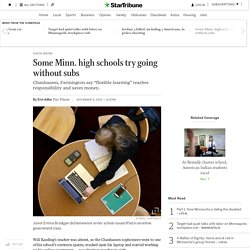
Chanhassen High, along with Farmington High, are among the first schools in the state to try letting students learn on their own rather than hiring substitutes to fill in for teachers. Administrators tout the change as “flexible learning,” an educational approach that teaches students responsibility — and saves districts tens of thousands of dollars a year. “Arbitrarily getting a babysitter just because that’s what we have always done makes no sense whatsoever,” said Tim Dorway, Chanhassen High School principal. On average, he said six to seven of the school’s 100 teachers are absent on a given day. School officials say the concept could spread, given increasing emphasis on technology in schools. When Inclusion of One Excludes All (a guest post by A Non Mouse) In the interest of being an open conversation this blog will occasionally host guest writers.

In some cases those authors will wish to remain anonymous, and in those cases the post will be published under the A Non Mouse label. The content of guest posts is not necessarily endorsed by me, but agreement is not the same as worth being read. For Students, Why the Question is More Important Than the Answer. Thinkstock In a traditional classroom, the teacher is the center of attention, the owner of knowledge and information.

Teachers often ask questions of their students to gauge comprehension, but it’s a passive model that relies on students to absorb information they need to reproduce on tests. What would happen if the roles were flipped and students asked the questions? That’s the premise of the Right Question Institute and a new book by its co-directors Dan Rothstein and Luz Santana.
A Very Good Plagiarism Cheat Sheet for Teachers and Educators. Six things kids need to succeed at school — but too many don’t get. Elmer’s school glue is displayed for sale with supplies at a Wal-Mart Stores Inc. location in the Porter Ranch neighborhood of Los Angeles, California, U.S., on Thursday, August 6, 2015.

Empathy in Action: How Teachers Prepare Future Citizens. How do children learn to care enough about others that they reap the personal rewards associated with giving?
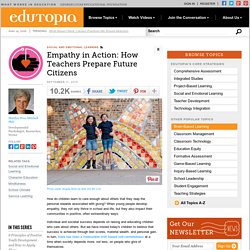
When young people develop empathy, they not only thrive in school and life, but they also impact their communities in positive, often extraordinary ways. Individual and societal success depends on raising and educating children who care about others. But we have misled today's children to believe that success is achieved through test scores, material wealth, and personal gain. Defining Organizational Culture. Have you ever noticed how service can vary from restaurant to restaurant? At some, you walk in and are greeted by a friendly, attractive host who whisks you away to an available table; at others, you can't get anyone to make eye contact with you, let alone greet you in a friendly way.
Often, such a disparity can be found among restaurants that are part of the same chain! What is going on? How can two restaurants from the same company be so dramatically different? Similar disparities can be found between and within schools and districts: You walk into some schools and immediately feel welcome; you walk into others and you feel like an intruder. 10 Ways Mobile Devices Have Changed Education. 15 Essential Apps For The Organized Teacher. Organization Apps? Here Are 15 Essential Apps For The Organized Teacher by TeachThought Staff There is no single way to effectively organize a classroom. The big idea behind organization is systematic accessibility. When there is a clear system that allows the parts of that system to be accessible to those who need it, that’s organization.
Because organization is a subjective idea, what works for one teacher may not work for another. These are apps that allow teachers to store files, manage class rosters, share student work, and consolidate everything into a single, synced calendar for all parents. SimplyCircle asked us to check out their app, and if we thought it was worth sharing, share it. 15 Essential Apps For The Organized Teacher; Best Apps For Teacher Organization; Organization Apps? Making Digital Artifacts Work: Part 1. This is the first post in a series about making digital artifacts of student learning work for you as a teacher. In this series we will discuss the types of digital artifacts we collect, how we manage them, and what to do with all of those great pieces of evidence of student learning.
What is a digital artifact? Digital artifacts can be photos, notes, student projects, blog posts, Tweets and just about anything that students create using digital tools. What Teachers Aren't Learning By Jeffrey Cipriani Sitting in the back of the classroom, right cheek pressed to a desk and tears drying on her chin, Mya squeezes a stress ball and smells a stick of lavender while I talk about units of measurement. "Mr. Cipriani," Jose whispers as I pass his desk. "Read this. " 7 accessibility features every teacher should know for back to school. It’s that time of the year again. Class Story- A New Excellent Platform for Teacher-Parent Communication. How to Teach Students to Evaluate the Quality of Online Information.
Is School For Everyone? Some Say ‘No’ Smartphones in the classroom: a teacher's dream or nightmare? A List of Some Good Teacher-tested Tools to Try in Your Class. Anti-socially mobile? What I really think about classroom tech. Back to school: Canada lagging in push to teach kids computer coding. Words of Wisdom for the Introverts in the Classroom 10 Excellent Google Drive Apps Teachers Should Try This School Year. Fortune. © Time Inc. Student-Led Conferences: Empowerment and Ownership.
5 Ways to Support Faculty who Teach with Emerging Technologies. 20 Edtech Concepts and Devices That Every Teacher Should Know About - Education Futures: Emerging Trends and Technologies in K-12. Google classroom intro. Interactive presentations: a round-up. iBooks About How to Use Apps in the Classroom. Creating Interactive Math Tasks With Google Sites. A Great New Tool to Help You Integrate Technology In Your Lesson Plans. Head back to school with new features in Google Classroom.
Professors at odds over technology’s role in the lecture hall. Resources Toolkit for New Teachers. Research: Happier Students Get Higher Grades in School. Anywhere Anytime Learning is Changing: Implications for Parents, HigherEd and K-12. The Best Advice for Creating Student-Centered Learning. Gates Foundation Sponsored: Effective Teaching. TodaysMeet - Give everyone a voice. 7 Education Disruptors that Are Making Learning More Fun.
Dcmooc. Classroom Management. Classroom design tips. Getting Technology Right in Schools. Who’s Telling Your Story? The critical role of teachers in transforming education systems — Changemaker Education. 8 Things to Look for in Today’s Professional Learning (Part 2) What will classrooms look like in the future? One Size Doesn’t Fit All. Creating Classroom Environments: Are You Ready for Technology? Dear Teachers, 7 beliefs about teaching routines that will cause you to lose your mind. Today’s Education Should Be About Giving Learners Voice and Choice. Why I Got Rid of My Teacher’s Desk — The Synapse. The top 10 edtech lessons I’ve learnt after 15 years in schools. The Secret to Successfully Implementing Edtech? Put Old Tech First.
20 Classroom Setups That Promote Thinking. Flexible Classrooms: Providing the Learning Environment That Kids Need. What You Miss When You Take Notes on Your Laptop. Uk.businessinsider. 3 Must Watch TED Talks on The Power of Life Long Learning. Over 14 Million Public Domain Images to Use with Students in Class. An under-appreciated way of teaching kids to think rationally. Be Wary of Putting the Cart Before the Horse. The 4 biggest mistakes that teachers make when integrating technology. This Is What Today's Online Learning Content Tells Us About The Future Of School. Tomorrow's Learning Today: 7 Shifts To Create A Classroom Of The Future.
Discover Brain Based Learning And How To Use It In Your Classroom. Can Teachers Author Their Own Textbooks on the Fly? Empower Teachers To Lead, Encourage Students To Be Curious. The Bare Walls Theory: Do Too Many Classroom Decorations Harm Learning? 10 Mac Tips Every Teacher Should Know about. 2015-nmc-horizon-report-k12-EN.pdf. The Learning Revolution Blog: What If Everything You Knew About Disciplining Kids Was Wrong? - MoJo Blogs and Articles. Reasons and Research – Why Schools Need Collaborative Learning Spaces.
Classroom Technology Is Not a Substitute for Teaching. University of Adelaide is phasing out lectures. Stop Penalizing Boys for Not Being Able to Sit Still at School - Jessica Lahey. 10 pieces of advice for new teachers: Our obsession with school achievement data is misplaced: we’re measuring the wrong things. OpEducation - Confronting Racial Injustice in Schools Archives. iPad classes are affecting our children's learning: parents. 5 Research-Based Tips for Providing Students with Meaningful Feedback. Teachers are shaming pupils because of exam pressure, report says. 10 Reasons Twitter Works In Education.
Why digital transformation is so difficult to achieve. What Wearable Tech Could Mean for the Classroom.